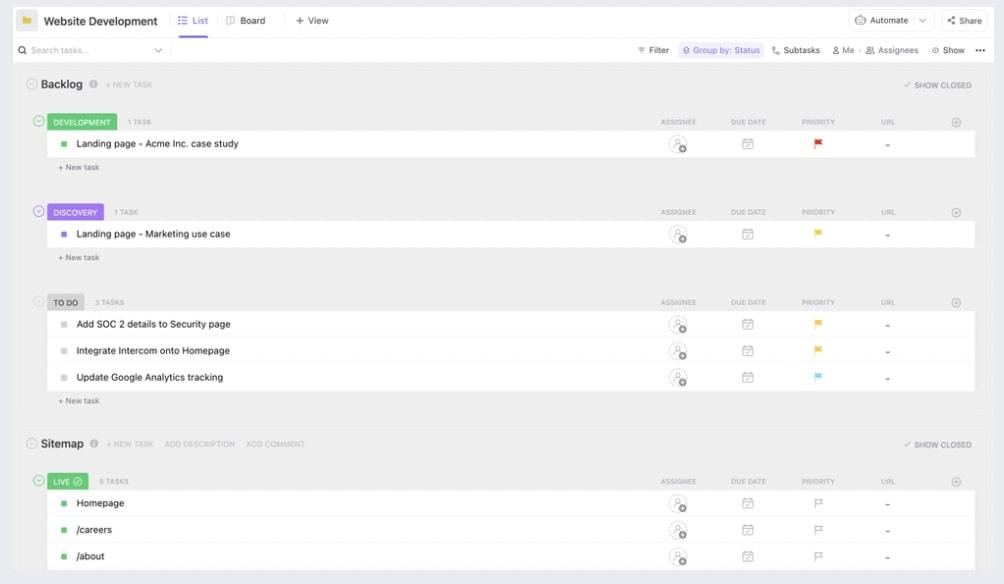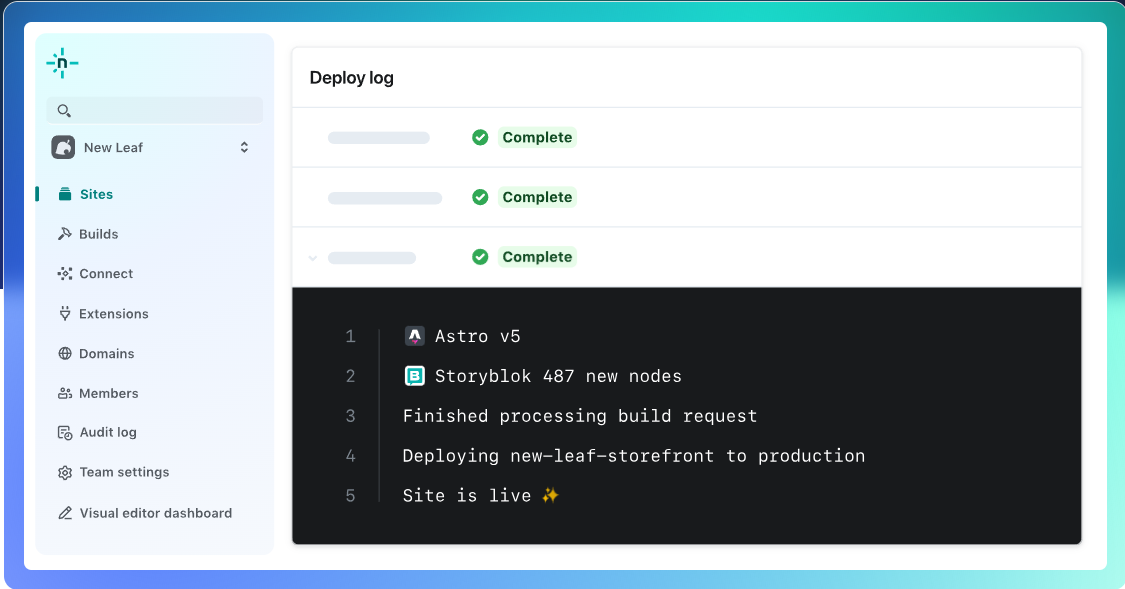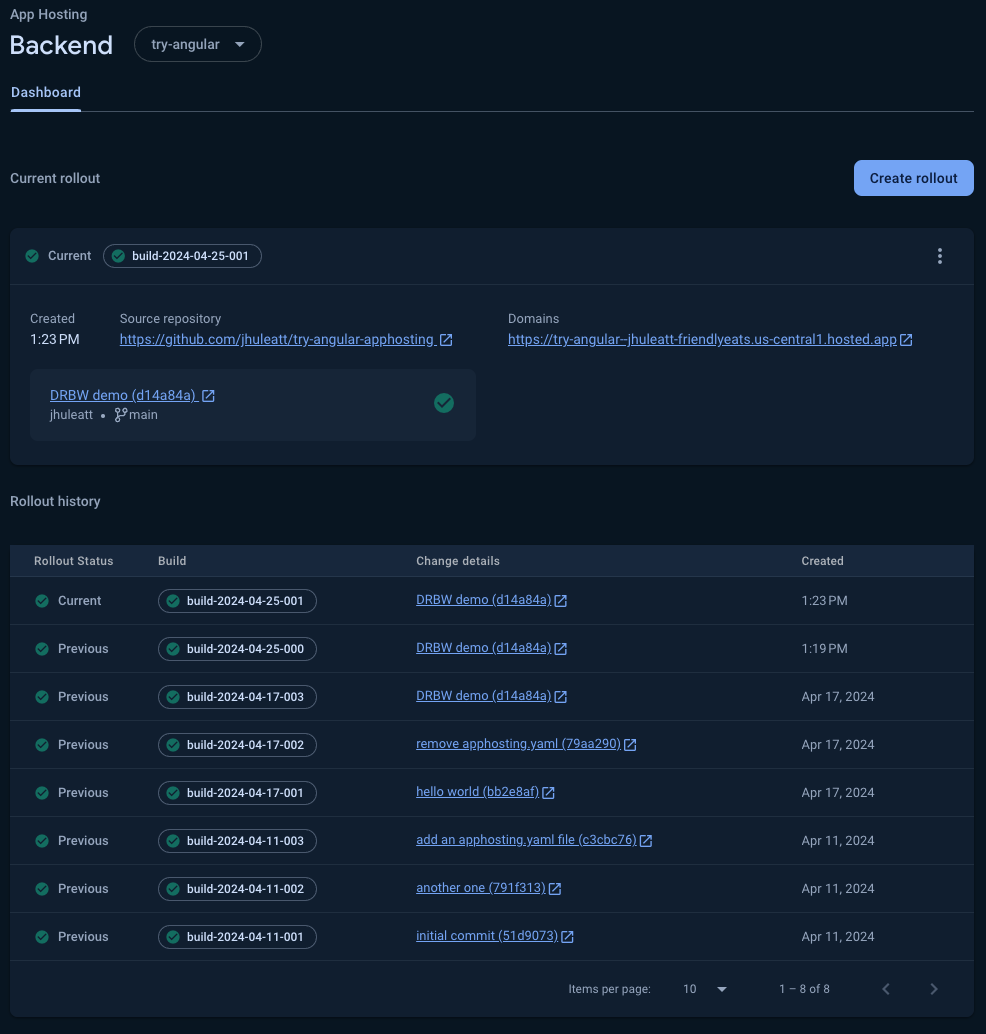Top 10 Vercel Alternatives for Faster Deployments in 2025

Sorry, there were no results found for “”
Sorry, there were no results found for “”
Sorry, there were no results found for “”

Vercel is known for its easy setup, seamless GitHub integration, and simplicity, making it a popular choice for creating frontend apps. However, the platform’s limited free tier and high pricing have become significant drawbacks for users.
While Vercel fits perfectly in an enterprise setting, it’s not affordable for startups, SMEs, and even large-scale enterprises in the long run. If you agree with this, you’re in the right place.
This listicle explores the top Vercel alternatives that have robust features, are cost-effective, and ensure the best developer experience.
So stick with us until you find your perfect match!
Here’s a quick comparison to get you started.
| Platform | Best For | Key Features | Limitations | Pricing | Ratings |
| Netlify | Static sites and modern app deployment built with JAMstack architecture | Built-in form handling, global CDN integration, serverless functions, site analytics | Cluttered interface, restrictive serverless function limits, buggy plugins | Free, Pro: $19/member/month, Enterprise: Custom pricing | G2: 4.5/5 (50+ reviews), Capterra: 4.6/5 (80+ reviews) |
| Render | Full-stack web apps with databases and backend services | Private networking, infrastructure as code, PostgreSQL database management | Limited WebSocket/serverless support, restricted language options | Hobby: $0, Professional: $19/user/month, Organization: $29/user/month, Enterprise: Custom pricing | G2: 4.7/5 (70+ reviews), Capterra: Not enough reviews |
| DigitalOcean App Platform | Scaling apps with complete server control | Git-based workflow, serverless architecture, deployment rollback, third-party log integration | Expensive for larger projects, lacks off-server backups, slow support during high traffic | Free, Droplets: Starts at $4/month, Kubernetes: Starts at $11/month | G2: 4.6/5 (600+ reviews), Capterra: 4.6/5 (140+ reviews) |
| AWS Amplify | Building and handling large-scale apps | Managed hosting, robust authentication, feature flag capabilities, real-time user dashboard | Steep learning curve, high costs if usage isn’t monitored, sluggish interface | Free for 12 months, Pay-as-you-go pricing | G2: 4.2/5 (80+ reviews), Capterra: Not enough reviews |
| Fly.io | Deploying containerized apps globally with infrastructure control | Managed containers, Kubernetes, persistent storage, Fly Proxy for load balancing | Region-based pricing, buggy setup process, manual deployment of changes | $5 free trial credit, Hobby: $5/month, Pay-as-you-go, Dedicated support: Starts at $29/month | G2: Not enough reviews, Capterra: Not enough reviews |
| Heroku | Rapid prototyping and managing web applications | App health metrics, language runtime metrics, real-time pipeline overview, one-click deployment | Limited SQL database analytics, expensive for SMEs | Eco/Basic: $5+/month, Production: $25+/month, Advanced: $250+/month, Enterprise: Custom pricing | G2: 4.2/5 (140+ reviews), Capterra: 4.6/5 (300+ reviews) |
| Firebase Hosting | Secure hosting of static and dynamic apps | Zero-configuration SSL, Firebase CLI for deployment, Realtime Database, one-click rollback | Limited security rules, high costs for large-scale projects, not ideal for complex queries | Spark: Free, Blaze: Custom pricing | G2: 4.5/5 (250+ reviews), Capterra: 4.6/5 (700+ reviews) |
| Kinsta | Managed hosting for WordPress | MySQL optimization, app performance monitoring, auto-backups, malware monitoring | Slow environment setup, no domain reservation, uncommon control panel | Single-site: $35/month, Multiple-site: $70/month, Agency: Starts at $340/month | G2: 4.8/5 (900+ reviews), Capterra: 4.8/5 (20+ reviews) |
| Surge.sh | Static web publishing and client-side apps | CORS support, custom domain names, pushState support for single-page apps | Limited customizations, command-line-based approach, no built-in CI/CD automation | Surge: Free, Surge Professional: $30/month | G2: Not enough reviews, Capterra: Not enough reviews |
| Kapstan | Managing complex cloud infrastructure | Multi-cloud support, auto-deployment, self-service developer portal | No native container launching capabilities (requires third-party tools like Docker) | Custom pricing | G2: Not enough reviews, Capterra: Not enough reviews |
| ClickUp | Streamlining software project management and DevOps workflows | Task management, GitHub integration, AI-powered code snippets, automations, bug tracking, customizable templates, real-time collaboration | Learning curve for new users, advanced features may require customization | Free, Unlimited: $7/user/month, Business: $12/user/month, Enterprise: Custom pricing | G2: 4.7/5 (4,000+ reviews), Capterra: 4.7/5 (3,000+ reviews) |
Whether you’re looking for more control over deployment, customizations, or self-hosting capabilities, selecting the right platform is crucial. Here are a few key features that are a must-have in Vercel alternatives.
Our editorial team follows a transparent, research-backed, and vendor-neutral process, so you can trust that our recommendations are based on real product value.
Here’s a detailed rundown of how we review software at ClickUp.
Let’s see the 10 best Vercel alternatives, their key features, pricing, benefits, and limitations.

Netlify’s powerful serverless platform has robust built-in features, especially for frontend developers. It automates frontend development, streamlines deployment, and seamlessly integrates with Git repositories.
The best part is that Netlify offers advanced features for more complex projects—from custom domains to HTTPS to split testing that helps evaluate user engagement by deploying site versions.
Netlify’s simplicity and power are unmatched. Its seamless CI/CD integration makes deploying websites and web apps incredibly straightforward, even for beginners, making the ease of implementation outstanding. The intuitive dashboard, paired with preview links, has streamlined my workflow for frequent deployments. While Netlify is fantastic overall, the free plan has limitations on build minutes and bandwidth, which can be restrictive for scaling projects.

Render’s unified platform helps you build and run applications. Whether you need a database, dynamic websites, static sites, or custom Docker files—Render has it all. Unlike Vercel, Render has native support for running containerized apps and services on a fully managed platform.
It offers block storage (known as persistent disks) to store data that must persist across deployments. This allows you to run stateful apps like databases without any DevOps tool add-ons.
It’s free to develop and deploy many other services (like Node.js) and can be integrated to provide one-click CI/CD setup with VCS like GitHub. However, its free tier is terribly slow in both in case of deployment and in case of server start time after the server is moved to sleep state.
💡Pro Tip: Connecting ClickUp to PostgreSQL databases allows you to replicate data. You can then store and analyze ClickUp data in comprehensive, relational databases, facilitating more complex queries.
📮ClickUp Insight: 37% of workers send follow-up notes or meeting minutes to track action items, but 36% still rely on other, fragmented methods. Without a unified system for capturing decisions, key insights you need may get buried in chats, emails, or spreadsheets.
With ClickUp, you can instantly turn conversations into actionable tasks across all your tasks, chats, and docs—ensuring nothing falls through the cracks.

DigitalOcean’s app platform is a PaaS (Platform-as-a-Service) that allows you to publish code to servers without worrying about the underlying infrastructure. It provide greater control over deployments while offering full-stack versatility.
The platform stands out for its simplicity and ease of use. It offers an intuitive Git-based workflow, allowing you to leverage Git for code collaboration, version control, and auto deploys. Plus, it supports serverless architecture through DigitalOcean Functions, a FaaS (Function-as-a-Service) platform to help you run codes without server management.
DigitalOcean’s pricing is based on the cloud solutions you choose. Here’s what its app platform pricing looks like:
DigitalOcean is fast, clean, was first in kind once they started, cheap, they have great documentation, they have tutorials, easy to use, fast, and serious customer support and great products. However, the last two months my droplet that runs my website stops working as expected and just hand and services get down, that’s maybe because they have added many other services and products and updates.
📖 Read More: IaaS vs. PaaS vs. SaaS

Designed for frontend developers, AWS Amplify offers a full-stack TypeScript developer experience, allowing you to integrate frontend and backend code seamlessly. The platform offers managed hosting and robust authentication features to help you create hassle-free onboarding flows with a fully managed user directory and pre-built sign-up, sign-in, and multi-factor auth workflows.
It also supports serverless apps by integrating with AWS Lambda and other SaaS tools, allowing developers to create and deploy apps without managing servers.
A powerful system for building full-stack apps but the learning curve is steep, and debugging can be complex.

Fly.io is for developers working with Docker containers extensively. It is a Vercel alternative that allows you to deploy Docker containers globally while giving you more control over the deployment process and a more traditional server environment.
You can think of Fly.io as your personal cloud, simplifying DevOps automation, especially if you’re working on databases or require custom configurations. Moreover, leveraging its features like private networking, global deployments, secure VPN, and hardware isolation makes it a potential fit for the personal cloud concept.
One of the great things is it is available in many regions, i.e. 16 regions. It has GitHub integration and fully automated and documented API which makes it better than others in the market. However, I felt it has limited automated health checks and fallover. Another thing is it has different pricing for different region. Company should come up with common plan for various regions.

Heroku by Salesforce is a unified platform that handles frontend, backend, and databases, unlike Vercel. It supports multiple programming languages and has seamless integration capabilities that accelerate development.
The best part is that the platform has robust features yet requires minimal configuration. It also supports one-click deployment of services like Postgres, Redis, and RabbitMQ.
Salesforce Heroku is a PaaS platform that I have grown to appreciate. It stands out for its simplicity in setting up, deploying code, and overall management. However, it is expensive and has many paid add-ons.
🧠 Did You Know? According to Statista, the most used programming languages among developers in 2024 were JavaScript followed by HTML/CSS and Python.

Firebase Hosting is a production-grade web hosting service by Google that simplifies deploying, managing, and delivering web assets. With the platform, you can quickly deploy web apps and static content.
Unlike Vercel’s frontend-focused services, Firebase offers a complete BaaS (Backend-as-a-Service) experience. This makes the platform more suitable for projects that require backend services, especially the ones that leverage Google’s ecosystem. Also, Firebase Hosting is a more popular choice for developers who use other Firebase services like Firebase Authentication, Firestore, or Cloud Functions.
Firebase is a good choice for many projects, especially smaller ones. It’s easy and quick to set up and use. The real-time database and authentication features are particularly useful. Smaller projects benefit from this tremendously. However, the cost of this service may be too high for some projects and the security rules are limiting and feel ambiguous to set up.
✨Fun Fact: Firebase was initially developed as a real-time database, specifically designed to build chat apps, in 2011 by Envolve. Later, Google acquired it in 2014.

Kinsta specializes in WordPress sites which makes hosting and managing site performance easy and streamlines your DevOps pipeline to speed up software delivery. The platform offers robust built-in features like intuitive staging environments and automatic backup, making it a great Vercel alternative.
What users love about Kinsta is that it’s built on Google Cloud Platform and has a user-friendly dashboard that helps manage multiple websites, clone sites, and environments centrally, monitor site performance, resources, security issues, and more.
It provides a very strong service and excellent performance, but the high price is an important factor in the customer’s decision to use its services. Also, there is no domain reservation or free domain submission. The options for services are few and the control panel is simple but uncommon and requires training.

A static site hosting platform, Surge lets you publish static webpages directly from the command line in just a few clicks. It’s a no-frills platform ideal for quick prototyping, creating custom web pages, and personal projects.
The software also lets you use custom domain names for free and blends into your tech stack as a simpler alternative to Vercel.

Kapstan is an enterprise-grade solution that auto-deploys web apps, gives you greater control over deployments, and manages multiple cloud environments. Unlike Vercel, Kapstan provides infrastructure isolation that lets you run apps in separate environments. It offers a complete development platform that seamlessly fits your DevOps workflow with extensive customizations.
Kapstan equips development teams to manage their infrastructure without needing DevOps expertise, accelerating the development process.
Kapstan doesn’t have native container launching capabilities. You must use third-party tools like Docker containers.
Phew! Now that you’ve explored the Vercel alternatives to speed up deployment, there’s one more tool worth adding to your development ecosystem.
Work today is broken. We’re all working in too many disconnected apps, and it’s killing team productivity. The constant switching between apps—copying, pasting, formatting, and sharing code blocks as well as messages—wastes time and increases the chances of miscommunication or losing important details.
While the above tools help you host, build, and deploy apps, you need a solution that brings your scattered work to one place. This is where you need a software project management tool.
ClickUp, the everything app for work, has specialized features that make it your potential DevOps teammate. 🤝
With ClickUp for Software Teams, you can plan, build, and ship all your apps in one place.
When working on software projects, ClickUp Tasks can streamline development workflows and help track software deployments by creating actionable tasks. You can assign these tasks with clear deadlines, track progress with custom statuses, add tags for easy search, and even Assign Comments and @mentions so nobody misses out on anything.
You can also link the tasks to GitHub commits, branches, and pull requests using the ClickUp-GitHub integration.

Managing your workload gets easier with ClickUp. ClickUp Brain, ClickUp’s built-in AI assistant, can help you generate code snippets, summarize project insights, and create technical docs.

On the other hand, ClickUp Automations can streamline workflows, handle routine jobs like approvals and status updates, and manage project handoffs. You can select from 100+ pre-built workflows and tailor them to meet your needs.
What more? ClickUp also helps with bug tracking and documentation. You can simplify bug tracking by using ClickUp Forms to collect bug requests, convert bug reports into actionable tasks with ClickUp Tasks, and prioritize bug management.
You can also document bug details using the collaborative ClickUp Docs, along with necessary screenshots and reproduction steps.

Not to forget, ClickUp has a vast library of templates that save time and effort. For instance, the ClickUp Website Development Template helps you visualize and plan the entire project.
With this template, you can:
Similarly, you can use the ClickUp Bug & Issue Tracking Template and the ClickUp Bug Report Template to track, record, and fix bugs in no time.
The best part? ClickUp’s robust features are available at an affordable price so you don’t have to spend a fortune to achieve your DevOps goals.
Vercel is undoubtedly one of the best tools for frontend deployments. However, its ever-increasing prices make it an unsustainable option for small and large businesses.
The top ten Vercel alternatives we’ve listed excel in their own ways. Now, make a choice based on your needs and goals so you get a tool that best fits your purpose. For instance, if hosting is your priority, consider Firebase, and if you want full-stack web development tools, try Netlify, Render, or DigitalOcean.
No matter which platform you choose, pair it up with ClickUp to enhance your development process. ClickUp offers several features that help you streamline deployment, fix bugs, organize resources and documentation, and collaborate in real time.
So, sign up for free to see ClickUp in action!
© 2025 ClickUp